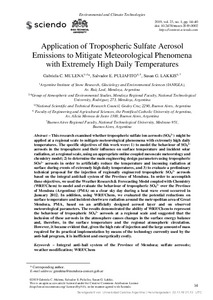Por favor, use este identificador para citar o enlazar este ítem:
https://repositorio.uca.edu.ar/handle/123456789/9135| Título: | Application of tropospheric sulfate aerosol emissions to mitigate meteorological phenomena with extremely high daily temperatures | Autor: | Mulena, Gabriela C. Puliafito, Salvador E. Lakkis, Susan Gabriela |
Palabras clave: | TROPOSFERA; SULFATOS; IONES; TEMPERATURA; CLIMA | Fecha de publicación: | 2019 | Editorial: | De Gruyter Open | Cita: | Mulena, G.C., Puliafito, S.E., Lakkis, S.G. Application of tropospheric sulfate aerosol emissions to mitigate meteorological phenomena with extremely high daily temperatures [en línea]. Environmental and Climate Technologies. 2019, 23(1). doi:10.2478/rtuect-2019-0002 Disponible en: https://repositorio.uca.edu.ar/handle/123456789/9135 | Resumen: | Abstract: This research examined whether tropospheric sulfate ion aerosols (SO4 2–) might be applied at a regional scale to mitigate meteorological phenomena with extremely high daily temperatures. The specific objectives of this work were: 1) to model the behaviour of SO4 2– aerosols in the troposphere and their influence on surface temperature and incident solar radiation, at a regional scale, using an appropriate online coupled mesoscale meteorology and chemistry model; 2) to determine the main engineering design parameters using tropospheric SO4 2– aerosols in order to artificially reduce the temperature and incoming radiation at surface during events of extremely high daily temperatures, and 3) to evaluate a preliminary technical proposal for the injection of regionally engineered tropospheric SO4 2– aerosols based on the integral anti-hail system of the Province of Mendoza. In order to accomplish these objectives, we used the Weather Research & Forecasting Model coupled with Chemistry (WRF/Chem) to model and evaluate the behaviour of tropospheric SO4 2– over the Province of Mendoza (Argentina) (PMA) on a clear sky day during a heat wave event occurred in January 2012. In addition, using WRF/Chem, we evaluated the potential reductions on surface temperature and incident shortwave radiation around the metropolitan area of Great Mendoza, PMA, based on an artificially designed aerosol layer and on observed meteorological parameters. The results demonstrated the ability of WRF/Chem to represent the behaviour of tropospheric SO4 2– aerosols at a regional scale and suggested that the inclusion of these aerosols in the atmosphere causes changes in the surface energy balance and, therefore, in the surface temperature and the regional atmospheric circulation. However, it became evident that, given the high rate of injection and the large amount of mass required for its practical implementation by means of the technology currently used by the anti-hail program, it is inefficient and energetically costly. | URI: | https://repositorio.uca.edu.ar/handle/123456789/9135 | ISSN: | 2255-8837 | Disciplina: | INGENIERIA AMBIENTAL | DOI: | 10.2478/rtuect-2019-0002 | Derechos: | Acceso abierto | Fuente: | Environmental and Climate Technologies. 2019, 23(1) |
| Aparece en las colecciones: | Artículos |
Ficheros en este ítem:
| Fichero | Descripción | Tamaño | Formato | |
|---|---|---|---|---|
| application-tropospheric-sulfate-aerosol.pdf | 1,7 MB | Adobe PDF |  Visualizar/Abrir |
Visualizaciones de página(s)
442
comprobado en 26-dic-2025
Descarga(s)
583
comprobado en 26-dic-2025
Google ScholarTM
Ver en Google Scholar
Altmetric
Altmetric
Este ítem está sujeto a una Licencia Creative Commons

